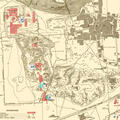Interaction networks of the Ravi Phase
Arrows extend from Harappa to likely source areas for raw materials such as agate, lapis lazuli, steatite, marine shell and copper. These raw materials were transformed into ornaments and tools at Harappa for local trade.
The Ravi Phase denotes a










